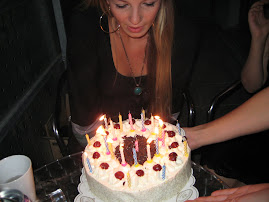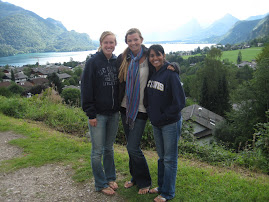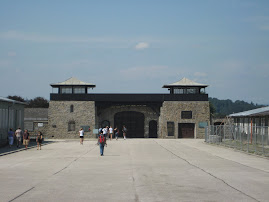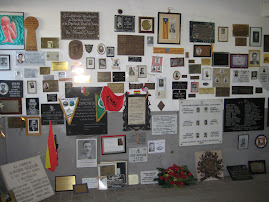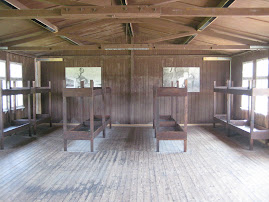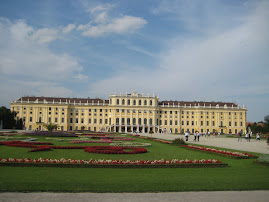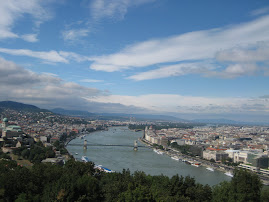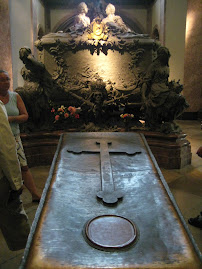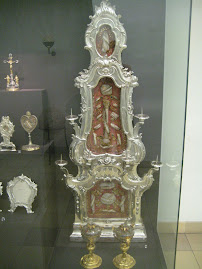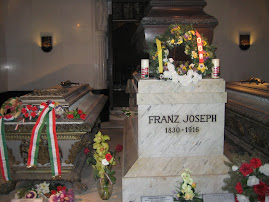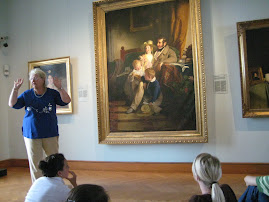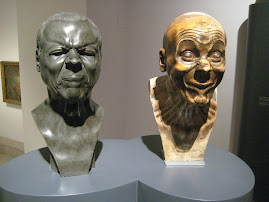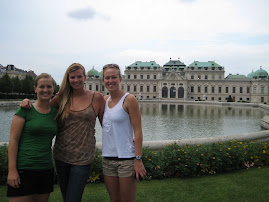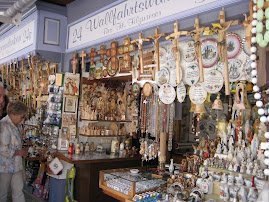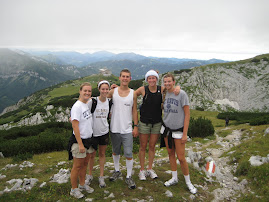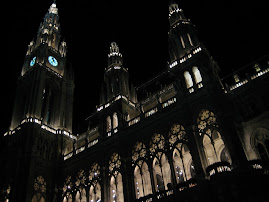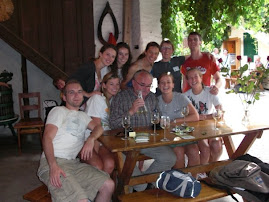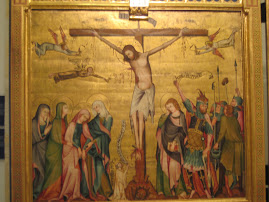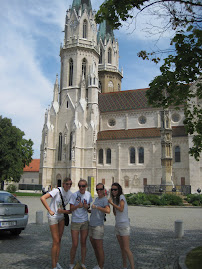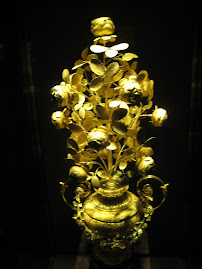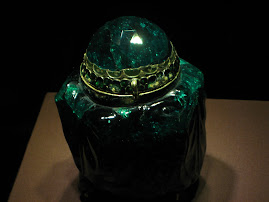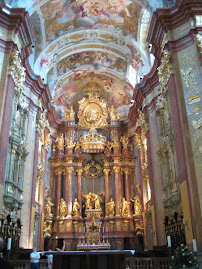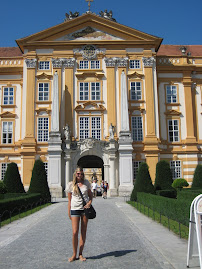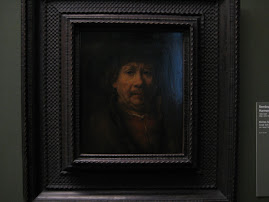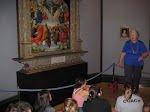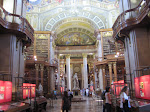After class, Lindsay and I headed over to a Bier Garten over near the Museums Quartier. We decided to grab a beer and some lunch, and we sat outside underneath the chestnut trees. We got some hemp beer and traditional Viennese food and chatted for awhile before heading over to the Wien Museum. The Wien Museum is located in the Karlsplatz area which is a pretty central location of Vienna. I was a little weary heading to another museum after seeing so many up to this point, but it turned out to be a really great museum that was completely different from what I expected. I really liked it because it was an assemblage of history, art, artifacts, photographs, and really interesting facts about Vienna starting from pre-historic times leading through the ages up to the 21st century giving helpful overviews on all the different eras that have characterized Vienna making it the city that it is, today. Because there were three stories of artifacts and information, I will focus on several areas that seem to be most relevant to what we’ve been studying as a class.
The bottom floor had a lot of information on St. Stephen’s Cathedral, its origins, remodeling, and current status as one of the oldest, most recognizable structures in Vienna. I learned that during the reign of the Babenbergs, construction on St. Stephens began right around 1137-1160. It was constructed during the late-Gothic period, and was re-done a hundred years later with a bit of Romanesque style. At the time of its consecration in 1147, it was the second highest steeple in the world. The Diocese of Passau helped oversee construction and was also the 1st Viennese Bishop. In the late Middle Ages around 1304, it was re-built in the Gothic architectural style which is how it remains today although there has been lots of reconstruction and renovations over the centuries that the cathedral has been in existence. In the 18th century the interior was refurbished in the grand Baroque style. The building was badly damaged in World War II, but a lot of artifacts in the Wien museum such as original stained glass windows dating back to 1340 and pillars from the west facade of St. Stephens- statues of Duke Rudolph IV and his wife Catherine of Bohemia are all preserved in good condition. The cathedral has replaced these originals with replicas to maintain the original look, but preserve the historic artifacts of the past. In addition to these original peices, the Wien museum is also in possession of 250 medieval sculptures made from sandstone that have been weathered and a little decayed from pollution, altar panels, frescoes from the early Italian Renaissance, a medieval suit of armor and shield, and more stained glass that was rescued from a fire in 1945. It was really interesting seeing all these original statues and artifacts, especially because the cathedral has since been restored with replicas.
The second floor contains art and historical remnants from the 17th and 18th century Vienna. Some of the things that caught my eye on this floor include the last executioner’s sword used in Vienna which is on display (the last state-ordered execution was performed in 1786), a wheel used to crush people to death back when corporal punishment was common, a drawing of a bird’s eye view of Vienna dating from the middle of the 17th century (which looks MUCH different than the Vienna we know today), and several paintings depicting historic moments in Vienna’s past such as Franz Geffel’s The Relief Battle depicting the near- defeat of Vienna from the Turks until at the last moment, allies swept over the hills rescuing the city and decisively defeating the Turkish army.
This floor also contained a lot of art and information about Baroque Vienna. In this period of the decades following the Turkish wars, Vienna grew into an international center for the arts. The royal court, aristocracy, figures such as Prince Eugene of Savoy, and the Catholic Church, all contributed in building some of Vienna’s most identifiable structures such as Schonbrun Palace, the church of St. Charles, upper and lower Belvedere, and more. The architecture, sculptures, paintings, and interior decor of the baroque period were reflections of one’s social position and influence including the highly esteemed Catholic church. Baroque flourished under the court of Maria Theresia and Franz I and the style is characterized most by its grandeur style, using elaborate materials that down the smallest details evoke a sense of awe aimed to impress visitors and guests. The baroque style was only used by the wealthiest of aristocrats and royalty so it came to reflect a sense of power and dominance through wealth and prestige (as I mentioned in my description of Prince Eugene of Savoy’s Belvedere Palace.)
The third floor contained a lot of Biedermier art and household objects. These paintings are all evoke a warm and fuzzy feeling whether depicting scenes of a middle class girl buying goat milk in the countryside with Vienna in the background, men casually hanging out playing the cello and listening to music, wholesome romance scenes of two lovebirds, families gathered around each other in their cozy homes, or a little girl casually lying on a chair with toys all over the floor and a content little dog by her side. The Biedermier style occurred during a time of intense scrutiny from the state, but also during a time of vast change and development. While these scenes depict cozy families and middle class comfort, the reality of this period in Vienna’s history is that the population went from 240,000 in 1800 to 410,000 in the year 1846 due to people migrating from the countryside to the city in an era of industrialization. Vienna was experiencing technological change, social tension, and political repression, so this Biedermier art almost seems to reflect a class of people in denial of reality and closely grasping on to a life and time period, "the good old days" rapidly slipping away.
On this floor I also learned about the revolution of 1848 which started out as a peaceful student demonstration turned violent. Dozens of students and peasants protesting the absence of individual rights during a time of enlightenment and revolution were killed by a firing squad after being arrested. Paintings in this section depicted the protestors and lynch mobs.
Finally, the 20th century section explained Vienna’s collision of tradition and modernity, and the movement that came out of this called the secession. The secession was founded by a group of artists who wanted to break free from tradition dominated by historic and religious art. They were in favor of reforming the art scene into a contemporary, modernized, liberal take on art accepting of different styles and methods other than those promoted by the conservative monarchs. Gustav Klimt was a founder of this movement, and the Secession building in the Karlsplatz is where their art exhibits were on display. In addition to this movement of modern art, other domains such as music (such as composer Arnold Schonberg), literature, and psychology (Sigmund Freud) were also making huge advances during this time in Vienna. This part of the exhibit holds Klimt’s "Liebe" (1895) and "Bidnis Emilie Floge" (1902) which were also enjoyable to see.
Saturday, August 30, 2008
The Opera: Tuesday, August 19th
Mozart's The Magic Flute
On Tuesday, August 9th, our entire class went to see the opera at Theater An Der Wien. The opera was Mozart’s The Magic Flute and after reading the libretto and discussing it in class, I was really excited to see the opera. I’ve been to many plays and musicals but seeing the opera in Vienna is a completely different experience. I’ve read a lot about Viennese culture and have learned that two things the people here really love are theater and music. When we arrived at the opera on a Tuesday evening, I wasn’t surprised to see the theater packed with locals, their children, and tourists alike all brought together to enjoy the Mozart’s exquisite music and the children’s whimsical fairytale written by Emanuel Schikaneder. Mozart and Schikaneder were Free Masons together so they collaborated to create The Magic Flute in 1791 (which contains a lot of Masonic imagery and elements of the Enlightenment). The story is about a young princess named Pamina who is kidnaped by the moor, Monostatos and Tamino sets out on a journey to find his love but must first go through a series of trials in order to rescue the princess.
Visually, the opera was completely different than what I expected. I thought it would be really old-fashioned with ornate sets and dress reflecting the late18th century fashions. Instead, the set was really simple and almost seemed like the inside of a nursery with huge, colorful doors that made up the three bordering walls of the stage. The set was fairly simple and remained the same throughout the length of the play besides for some basic props here and there (such as a ramp that doubled as a table, etc.) The costumes were bright and colorful, and almost circus-like in their style. All the supporting actors had crazy, bizarre hairdos with colorful designs in an almost modern-art style. Pretty much all the characters except Tamino and Pamina, wore these crazy circusey outfits, while Tamino wore black overalls over a white shirt and Pamina wore a simple, blue dress that could have been that of a country peasant (hardly what I was expecting/hoping a princess would wear.) The opera had beautiful music which pretty much saved the experience for me. I wasn’t impressed (or maybe just completely surprised and disappointed) at the set, style, and costumes, but the music was absolutely amazing, especially hearing Mozart being performed live by such a talented orchestra. The opera singers were also extremely talented, but my favorite was The Queen of the Night. She played Pamina’s mother but was portrayed as dark because of her strong female character devoid of a man to supervise and thus subdue her. The actress playing the Queen of the Night hit these amazing high notes to a point where no one else in the production could compare with her singing talents. Every time she came on stage, she carried this energy with her, and I immediately perked up to watch her every move and listen carefully to her incredible vocalization.
The theater itself was also something to pay attention to and admire. Kathy told me that this is one of the oldest theaters in Vienna and even precedes the huge opera house near our classroom that seems to be a historic symbol of the opera and musical traditions here. Inside the theater, there are beautiful statues lining the walls, ornate details along all the molding and trim, and traditional little balconies that line three floors of seating. The theater is really condensed but tall, with many different layers. It was clearly built centuries ago because the people must have been much smaller. One of my difficulties with enjoying the performance was that I was really uncomfortable the whole time. Back in the day when the museum was built im sure the people were on average much smaller and shorter. This caused me some problems because im really tall, must mostly have long legs and they physically couldn’t even fit in front of me, so I spent the entire opera with my legs to the side, which got pretty uncomfortable. Of course I was still able to appreciate and enjoy the opera, but next time im going for the aisle seat. :)
On Tuesday, August 9th, our entire class went to see the opera at Theater An Der Wien. The opera was Mozart’s The Magic Flute and after reading the libretto and discussing it in class, I was really excited to see the opera. I’ve been to many plays and musicals but seeing the opera in Vienna is a completely different experience. I’ve read a lot about Viennese culture and have learned that two things the people here really love are theater and music. When we arrived at the opera on a Tuesday evening, I wasn’t surprised to see the theater packed with locals, their children, and tourists alike all brought together to enjoy the Mozart’s exquisite music and the children’s whimsical fairytale written by Emanuel Schikaneder. Mozart and Schikaneder were Free Masons together so they collaborated to create The Magic Flute in 1791 (which contains a lot of Masonic imagery and elements of the Enlightenment). The story is about a young princess named Pamina who is kidnaped by the moor, Monostatos and Tamino sets out on a journey to find his love but must first go through a series of trials in order to rescue the princess.
Visually, the opera was completely different than what I expected. I thought it would be really old-fashioned with ornate sets and dress reflecting the late18th century fashions. Instead, the set was really simple and almost seemed like the inside of a nursery with huge, colorful doors that made up the three bordering walls of the stage. The set was fairly simple and remained the same throughout the length of the play besides for some basic props here and there (such as a ramp that doubled as a table, etc.) The costumes were bright and colorful, and almost circus-like in their style. All the supporting actors had crazy, bizarre hairdos with colorful designs in an almost modern-art style. Pretty much all the characters except Tamino and Pamina, wore these crazy circusey outfits, while Tamino wore black overalls over a white shirt and Pamina wore a simple, blue dress that could have been that of a country peasant (hardly what I was expecting/hoping a princess would wear.) The opera had beautiful music which pretty much saved the experience for me. I wasn’t impressed (or maybe just completely surprised and disappointed) at the set, style, and costumes, but the music was absolutely amazing, especially hearing Mozart being performed live by such a talented orchestra. The opera singers were also extremely talented, but my favorite was The Queen of the Night. She played Pamina’s mother but was portrayed as dark because of her strong female character devoid of a man to supervise and thus subdue her. The actress playing the Queen of the Night hit these amazing high notes to a point where no one else in the production could compare with her singing talents. Every time she came on stage, she carried this energy with her, and I immediately perked up to watch her every move and listen carefully to her incredible vocalization.
The theater itself was also something to pay attention to and admire. Kathy told me that this is one of the oldest theaters in Vienna and even precedes the huge opera house near our classroom that seems to be a historic symbol of the opera and musical traditions here. Inside the theater, there are beautiful statues lining the walls, ornate details along all the molding and trim, and traditional little balconies that line three floors of seating. The theater is really condensed but tall, with many different layers. It was clearly built centuries ago because the people must have been much smaller. One of my difficulties with enjoying the performance was that I was really uncomfortable the whole time. Back in the day when the museum was built im sure the people were on average much smaller and shorter. This caused me some problems because im really tall, must mostly have long legs and they physically couldn’t even fit in front of me, so I spent the entire opera with my legs to the side, which got pretty uncomfortable. Of course I was still able to appreciate and enjoy the opera, but next time im going for the aisle seat. :)
The Belvedere: Friday, August 15th
The Belvedere was constructed as the palace for Prince Eugene of Savoy, a great war hero of his time. He admired other war heroes such as Alexander the Great, and had sculptures of him and others all around his entry way where guests arrive. He also showed his defeat of the Turks by making them column/statues who held up the building. Prince Eugene of Savoy wanted to show off his appreciation for the arts through Belvedere, with beautiful Italian murals on the ceilings, rooms full of marble with sparkling chandeliers hanging from the ceiling, sculptures exuding images of strength and power, and minute details in every aspect of the palace. The irony is that the grand "upper" palace of Belvedere was his guest house, while his own residence was located in lower Belvedere, in a much more humble, modest building at the base of the gardens.
I was really excited to go on the Belvedere tour with our museum guide, Dr. O and it turned out to be one of my favorite class trips thus far. Although Gustav Klimt is a huge cult figure in Vienna and you can hardly walk two blocks down the street without seeing his work turned into a scarf, tote bag, or shot glass, I have been a fan of his work long before I came to this city. My sister is a fan of Klimt’s art and introduced me to his work awhile ago, so I have been highly anticipating our tour of the Belvedere. It turned out the Klimt was one of the last artists we looked at, and there were some other really amazing exhibits preceding his.
The first exhibit that Dr. O dissected for us was that of the sculptor, Franz Xaver Messerschmidt, and is called "Character Heads." Messerschmidt has an incredible story leading up to these character head creations. He was once the court sculptor during the reign of Maria Theresia and created conventional statues of the Empress and her husband. Right around 1774, when he was in his mid-thirties, the sculptor was up for promotion to the department head of the art academy but was passed over and someone else got the job. Even after he quit his position as court sculptor, and Maria Theresia tried to make amends with offering high positions in the court and a handsome salary, Messerschmidt was permanently turned off from having anything to do with Vienna or the royal court. He moved to Bratislava where he lived a reclusive life and was said to torture himself while living in seclusion. Messerschmidt had gone from a notorious court sculptor to a virtually ignored schizophrenic. His art reflected his tormented psyche and he began to sculpt heads with extremely intensely animated expressions. The heads were all modeled after his own expressions of pain, sadness, delusion, anger, and even a distorted happiness that he created by torturing himself in the mirror and sculpting the very facial expressions that he, himself made. When the sculptor was dying of pneumonia he threw half of his sculptured into a nearby river, and today 54 of the original 69 are known to exist (and a huge portion are in the Belvedere.) Even though these sculptures were created during the days of Messerschmidt’s insanity, they still reflect his incredible talent and are haunting in their realistic appearance. He also worked with many different materials such as marble and lead (which couldn’t have helped much with his sanity issues.) I was completely blown away by both his talent, and the sorrow of this great sculptor’s life story which led him to such a state of mind to create these disturbing heads.
The next exhibit that really interested me was the Biedermier style of art. I really enjoyed these paintings, although I don’t necessarily think I am the Biedermier type. Biedermier is a term that was adopted after the Napoleonic wars when the Austrian monarchy cracked down on the citizens and began to closely censor the lives of all citizens in order to stifle any possibility of revolution. In German, the term is "Reaktion" and this way of life existed from about 1815-1848 and onwards. The monarchy imposed a system of spies, underground informants, and secret agents to alert those in power of any possible revolutionary activity, after the American and French revolutions led to democracy and monarchies around Europe were beginning to crumble in this new age of Enlightenment. Biedermier became the domestic response of the people and defined not just a way of life, but art, interior design, and an emphasis on the family. People turned inwards and reacted to the strict public sanctions by focusing on the family and home. This coping mechanism applied mostly to the middle and upper-middle class, who had the resources to decorate their homes with luxurious yet comfortable furniture, rear well-mannered children, take part in music, arts, games, host small gatherings to entertain their inner circles, and most of all uphold privacy. The art reflecting this time period of Austrian history is very family oriented, with portraits of children in the laps of their loving parents and toys scattered about the floor in a lovely, yet liveable home. There are paintings of couples in love, playing music, or gazing at each other with devotion. There is a balance of properness and playfulness, well-mannered but easy going, and aesthetic yet practical. Frederick von Amerling is the artist who painted a beautiful portrait of a father and his three children in their upper-middle class Biedermier home. I really like this art style because it often tells a story of the people and their lives portrayed in the paintings. They come alive and its almost like you can peek into their personal, private lives to catch a little glimpse of what it was like for them in the stifling "era of Meternech.."
I was really excited to move on to the Gustav Klimt room. My two favorite paintings in there were the Judith of Holofernes and of course, The Kiss. The Judith painting was completed in 1902 and shows this image of a beautiful, seductive, mostly naked woman who appears to have truly enjoyed (in an almost sexual way) decapitating the man that threatened her village with his army (in the Biblical story.) She is a great example of Klimt’s obsession with women and "the feminine mystique." He also used his characteristic gold leafs to bring the painting alive with shimmering splendor. The Kiss was also amazing, especially after seeing it reprinted so many times, to see it in person was completely different. The painting is a lot larger in real life than I expected, and there is so much more detail that I noticed when seeing it in real life. Dr. O explained that the use of mosaics was inspired from Klimt’s trips to Venice where he admired the stained glass in St. Mark’s, and the shimmering waters of the canals. He also depicts the female figure as soft, flowing, and circular oval shape compared to the man’s more rectangular, masculine shape. We discussed the painting for a while and whether or not the woman enjoys being kissed or is pulling away from the man. My personal opinion (because im a romantic) is that she enjoys the kiss and is lovingly falling into his arms. Overall, the Belevedere was a really enjoyable museum to visit, and once again, I learned a lot and was highly entertained by Dr. O’s tour.
I was really excited to go on the Belvedere tour with our museum guide, Dr. O and it turned out to be one of my favorite class trips thus far. Although Gustav Klimt is a huge cult figure in Vienna and you can hardly walk two blocks down the street without seeing his work turned into a scarf, tote bag, or shot glass, I have been a fan of his work long before I came to this city. My sister is a fan of Klimt’s art and introduced me to his work awhile ago, so I have been highly anticipating our tour of the Belvedere. It turned out the Klimt was one of the last artists we looked at, and there were some other really amazing exhibits preceding his.
The first exhibit that Dr. O dissected for us was that of the sculptor, Franz Xaver Messerschmidt, and is called "Character Heads." Messerschmidt has an incredible story leading up to these character head creations. He was once the court sculptor during the reign of Maria Theresia and created conventional statues of the Empress and her husband. Right around 1774, when he was in his mid-thirties, the sculptor was up for promotion to the department head of the art academy but was passed over and someone else got the job. Even after he quit his position as court sculptor, and Maria Theresia tried to make amends with offering high positions in the court and a handsome salary, Messerschmidt was permanently turned off from having anything to do with Vienna or the royal court. He moved to Bratislava where he lived a reclusive life and was said to torture himself while living in seclusion. Messerschmidt had gone from a notorious court sculptor to a virtually ignored schizophrenic. His art reflected his tormented psyche and he began to sculpt heads with extremely intensely animated expressions. The heads were all modeled after his own expressions of pain, sadness, delusion, anger, and even a distorted happiness that he created by torturing himself in the mirror and sculpting the very facial expressions that he, himself made. When the sculptor was dying of pneumonia he threw half of his sculptured into a nearby river, and today 54 of the original 69 are known to exist (and a huge portion are in the Belvedere.) Even though these sculptures were created during the days of Messerschmidt’s insanity, they still reflect his incredible talent and are haunting in their realistic appearance. He also worked with many different materials such as marble and lead (which couldn’t have helped much with his sanity issues.) I was completely blown away by both his talent, and the sorrow of this great sculptor’s life story which led him to such a state of mind to create these disturbing heads.
The next exhibit that really interested me was the Biedermier style of art. I really enjoyed these paintings, although I don’t necessarily think I am the Biedermier type. Biedermier is a term that was adopted after the Napoleonic wars when the Austrian monarchy cracked down on the citizens and began to closely censor the lives of all citizens in order to stifle any possibility of revolution. In German, the term is "Reaktion" and this way of life existed from about 1815-1848 and onwards. The monarchy imposed a system of spies, underground informants, and secret agents to alert those in power of any possible revolutionary activity, after the American and French revolutions led to democracy and monarchies around Europe were beginning to crumble in this new age of Enlightenment. Biedermier became the domestic response of the people and defined not just a way of life, but art, interior design, and an emphasis on the family. People turned inwards and reacted to the strict public sanctions by focusing on the family and home. This coping mechanism applied mostly to the middle and upper-middle class, who had the resources to decorate their homes with luxurious yet comfortable furniture, rear well-mannered children, take part in music, arts, games, host small gatherings to entertain their inner circles, and most of all uphold privacy. The art reflecting this time period of Austrian history is very family oriented, with portraits of children in the laps of their loving parents and toys scattered about the floor in a lovely, yet liveable home. There are paintings of couples in love, playing music, or gazing at each other with devotion. There is a balance of properness and playfulness, well-mannered but easy going, and aesthetic yet practical. Frederick von Amerling is the artist who painted a beautiful portrait of a father and his three children in their upper-middle class Biedermier home. I really like this art style because it often tells a story of the people and their lives portrayed in the paintings. They come alive and its almost like you can peek into their personal, private lives to catch a little glimpse of what it was like for them in the stifling "era of Meternech.."
I was really excited to move on to the Gustav Klimt room. My two favorite paintings in there were the Judith of Holofernes and of course, The Kiss. The Judith painting was completed in 1902 and shows this image of a beautiful, seductive, mostly naked woman who appears to have truly enjoyed (in an almost sexual way) decapitating the man that threatened her village with his army (in the Biblical story.) She is a great example of Klimt’s obsession with women and "the feminine mystique." He also used his characteristic gold leafs to bring the painting alive with shimmering splendor. The Kiss was also amazing, especially after seeing it reprinted so many times, to see it in person was completely different. The painting is a lot larger in real life than I expected, and there is so much more detail that I noticed when seeing it in real life. Dr. O explained that the use of mosaics was inspired from Klimt’s trips to Venice where he admired the stained glass in St. Mark’s, and the shimmering waters of the canals. He also depicts the female figure as soft, flowing, and circular oval shape compared to the man’s more rectangular, masculine shape. We discussed the painting for a while and whether or not the woman enjoys being kissed or is pulling away from the man. My personal opinion (because im a romantic) is that she enjoys the kiss and is lovingly falling into his arms. Overall, the Belevedere was a really enjoyable museum to visit, and once again, I learned a lot and was highly entertained by Dr. O’s tour.
Monday, August 25, 2008
Trip to the Alps (including Weiner-Neustadt and Mariazell)
On Tuesday, August 12th, our entire class hopped on a bus and headed south towards the Austrian Alps. Along the way we stopped in a quaint little town called Wiener-neustadt. Here we went on a tour of the small town and hit all the main spots of interest including the military academy, a couple really old churches, a cathedral, and an abbey. We learned on our tour that this small town was hit the hardest of any town in Austria, during World War II. It was a target of bombing from air raids because of the aircraft production plant, and the famous Theresian Military Academy (founded by Maria Theresia in 1752) trained soldiers from all over the country and is symbolic to Austria as one of the first defense organizations. Over 80 percent of the town was destroyed in the bombing, and of the 4,000 residents that lived there only 800 remained after the war (most were killed or fled the city).
Weiner-Neustadt ("New Vienna") was constructed by Babenberg, Leopold V in 1194 to serve as a line of defense against Hungarian invaders. Maximillian I was born here, and was also buried in St. George’s Cathedral (which we visited on our tour). One interesting fact about Maximillian I is that he requested to have a humble burial without all the frills and excess of most imperial funerals, as he was an incredibly devout Catholic and pious man. After he died, Maximillian’s body was placed in a simple sack and (as he had requested) his legs were beaten and broken below the knees so he would be kneeling for all eternity. We also toured the main cathedral which was completed in the late 15th century, and is of a gothic style on the outside, but baroque on the interior. After the tour we had a few hours to get food and walk around town. A few girls and I went to this little Greek restaurant right outside the abbey which had really good food and grape vines growing all around it. Around three we headed back to the bus to continue on to the Alps.
When we got to the Alps a little while later, we took a gondola up to the top of this huge mountain which overlooked green valleys and little towns scattered about as far as the eye can see. On the top of the mountain sat this really old fashioned, traditional looking alpine lodge which was a restaurant, gondola station, and hotel all in one. Its was three stories and pretty basic in terms of quality. The rooms were small with simple bunk beds and a sink, but still cute all the same. It kind of felt like we were in a rustic, old fashioned summer camp, but the dinginess didn’t matter because we were in the middle of the beautiful Alps! Immediately upon arrival a group of us decided to walk up the trail and explore the area where our lodge is. We walked about a mile up the road, frolicking and laughing out of excitement to be out of the city and in this breathtaking scenery, right at dusk. We headed back for dinner, and we sat down to a meal of soup followed by pasta with meat sauce. The food tasted great, mostly because we were really hungry at that point! After dinner a bunch of us drank some wine and socialized, then decided to go on a "night hike." The "hike" was more of a 5 or 10 minute walk up the road where we all proceeded to plop in the grass and tell funny/ scary stories. After a while we headed back to the lodge to get some sleep for the next day’s activities.
The next morning I woke up, ate breakfast, and got dressed for a hike to this lodge high up on a mountain top, called the Habsburghaus. I had been feeling pent up and was starting to get agitated, im not sure if it was the constant group activities, or living in the middle of an urban city which im not used to, but as soon as I got out in the mountains and began to hike, I immediately felt in relieved to be in my element. A few girls and I led the way and we trecked along at a brisk pace only to stop occasionally for water or pictures. After several miles of walking along hillsides, down into meadows filled with purple, yellow, pink, and white wild flowers, and along a rocky little path, we suddenly came to an opening where the road dropped hundreds of feet before us leading down into a deep valley with winding hills and more mountains beyond that. The path curved to the right and we headed up a steep, single lane trail full of rocks that led us straight up a mountain. The weather was nice and cool, overcast and a little damp which kept us from feeling too hot. However, once we had gotten up to a decent elevation, it felt like we were above the clouds or at least in the clouds, and it was hard to see farther than several yards in any direction. When the steep part of the trail evened out, we walking along a grassy slope and it was only about another half a mile until we got to the Habsburghaus. We were the first group to arrive (Me, Lindsay, Kelsey, Jeff, Hans, Robert and Erin), and were relieved at the sight of the cute lodge which welcomed us with warmth and friendly hosts (a husband and wife) who ran the place. I ordered a bowl of potato/zucchini soup which was delicious!! Other people ordered hot chocolate, or huge plates full of spaghetti. The rest of the group started to trickle in until everyone had made it within about 45 minutes or so of each other. After eating, Lindsay, Jeff and I decided to head back down the mountain (which was seven miles each way for a total of a 14 mile hike) and we made it back to the lodge in about an hour and a half. On the way down the mountain I was leading the group and was so focused on my footing that all of a sudden I looked up and was face to face with a huge brown and white cow! We started cracking up because it freaked us out, we were only about 5 feet away and almost walked right into them. They were really pretty, peaceful cows that luckily let us passed without any trouble. We walked really fast on the way down, but we were also talking the whole way which made time fly, and the three of us all went the same fast pace, which got us down the mountain almost two hours before the next group! We cleaned up and took naps before eating a delicious, traditional Austrian dinner of soup, and schnitzel with potatoes. After dinner most of us hung around and played card games, followed by some ghost stories upstairs.
The next day, I woke up and afer eating breakfast, headed down the mountain on the gondola to relax at the bottom and reflect a little on the last couple days. When the second half of the group got down, we boarded the bus once again and headed towards a town called Mariazell. This town was really pretty and cheerful, with lots of pastel-colored buildings all nestled at the base of a ski slope. The main attraction in town is the Mariazell Basilica, which draws thousands of tourists and Catholics per year as a renowned pilgrimage site of Europe. In 2007, Pope Benedict XVI came to Mariazell which is now the towns’ biggest selling point and claim to fame. The church was beautiful and baroque, and when we went inside it was in service. I was a little "churched-out" at this point, so I decided to tour around the town rather than spend more hours in another church. I walked all around the small town, and got the feeling that it’s entire tourism platform is centered first and foremost around the town’s 850 year old history and Basilica, and secondly it’s prime location as a ski-resort. I got really cheesy vibes from the town, that all the people who come here fall into this Catholic tourist trap where there are dozens of little stands all around the church selling Catholic propaganda such as Jesus-everything (you name it- candles, jewelry, t-shirts, crucifixes, figurines, snow globes, thimbles, even when you think its going to stop there, it doesn’t) along with more plastic-beaded rosaries than I’ve ever seen (or want to see) in my life. The people that come here just eat it up. Even the church itself jumps on board with the Catholic souvenirs. Inside the Basilica, one can purchase books, postcards, rosaries, rings, crucifixes, the list goes on. Im not Catholic (or religious at all) myself, so maybe its something I personally don’t understand, but I just got this really creepy feeling that the town and church (which is basically the heart and soul of the town) profiteers off of people who come here for religious purposes and are sucked into this tourist trap of Catholic commercialism which feeds off of religious consumers who hope to take a piece of this "pilgrimage" site home with them. The town was cute and picturesque, but it wasn’t my favorite place and I was admittedly glad to get back on the bus when it came time to leave.
Weiner-Neustadt ("New Vienna") was constructed by Babenberg, Leopold V in 1194 to serve as a line of defense against Hungarian invaders. Maximillian I was born here, and was also buried in St. George’s Cathedral (which we visited on our tour). One interesting fact about Maximillian I is that he requested to have a humble burial without all the frills and excess of most imperial funerals, as he was an incredibly devout Catholic and pious man. After he died, Maximillian’s body was placed in a simple sack and (as he had requested) his legs were beaten and broken below the knees so he would be kneeling for all eternity. We also toured the main cathedral which was completed in the late 15th century, and is of a gothic style on the outside, but baroque on the interior. After the tour we had a few hours to get food and walk around town. A few girls and I went to this little Greek restaurant right outside the abbey which had really good food and grape vines growing all around it. Around three we headed back to the bus to continue on to the Alps.
When we got to the Alps a little while later, we took a gondola up to the top of this huge mountain which overlooked green valleys and little towns scattered about as far as the eye can see. On the top of the mountain sat this really old fashioned, traditional looking alpine lodge which was a restaurant, gondola station, and hotel all in one. Its was three stories and pretty basic in terms of quality. The rooms were small with simple bunk beds and a sink, but still cute all the same. It kind of felt like we were in a rustic, old fashioned summer camp, but the dinginess didn’t matter because we were in the middle of the beautiful Alps! Immediately upon arrival a group of us decided to walk up the trail and explore the area where our lodge is. We walked about a mile up the road, frolicking and laughing out of excitement to be out of the city and in this breathtaking scenery, right at dusk. We headed back for dinner, and we sat down to a meal of soup followed by pasta with meat sauce. The food tasted great, mostly because we were really hungry at that point! After dinner a bunch of us drank some wine and socialized, then decided to go on a "night hike." The "hike" was more of a 5 or 10 minute walk up the road where we all proceeded to plop in the grass and tell funny/ scary stories. After a while we headed back to the lodge to get some sleep for the next day’s activities.
The next morning I woke up, ate breakfast, and got dressed for a hike to this lodge high up on a mountain top, called the Habsburghaus. I had been feeling pent up and was starting to get agitated, im not sure if it was the constant group activities, or living in the middle of an urban city which im not used to, but as soon as I got out in the mountains and began to hike, I immediately felt in relieved to be in my element. A few girls and I led the way and we trecked along at a brisk pace only to stop occasionally for water or pictures. After several miles of walking along hillsides, down into meadows filled with purple, yellow, pink, and white wild flowers, and along a rocky little path, we suddenly came to an opening where the road dropped hundreds of feet before us leading down into a deep valley with winding hills and more mountains beyond that. The path curved to the right and we headed up a steep, single lane trail full of rocks that led us straight up a mountain. The weather was nice and cool, overcast and a little damp which kept us from feeling too hot. However, once we had gotten up to a decent elevation, it felt like we were above the clouds or at least in the clouds, and it was hard to see farther than several yards in any direction. When the steep part of the trail evened out, we walking along a grassy slope and it was only about another half a mile until we got to the Habsburghaus. We were the first group to arrive (Me, Lindsay, Kelsey, Jeff, Hans, Robert and Erin), and were relieved at the sight of the cute lodge which welcomed us with warmth and friendly hosts (a husband and wife) who ran the place. I ordered a bowl of potato/zucchini soup which was delicious!! Other people ordered hot chocolate, or huge plates full of spaghetti. The rest of the group started to trickle in until everyone had made it within about 45 minutes or so of each other. After eating, Lindsay, Jeff and I decided to head back down the mountain (which was seven miles each way for a total of a 14 mile hike) and we made it back to the lodge in about an hour and a half. On the way down the mountain I was leading the group and was so focused on my footing that all of a sudden I looked up and was face to face with a huge brown and white cow! We started cracking up because it freaked us out, we were only about 5 feet away and almost walked right into them. They were really pretty, peaceful cows that luckily let us passed without any trouble. We walked really fast on the way down, but we were also talking the whole way which made time fly, and the three of us all went the same fast pace, which got us down the mountain almost two hours before the next group! We cleaned up and took naps before eating a delicious, traditional Austrian dinner of soup, and schnitzel with potatoes. After dinner most of us hung around and played card games, followed by some ghost stories upstairs.
The next day, I woke up and afer eating breakfast, headed down the mountain on the gondola to relax at the bottom and reflect a little on the last couple days. When the second half of the group got down, we boarded the bus once again and headed towards a town called Mariazell. This town was really pretty and cheerful, with lots of pastel-colored buildings all nestled at the base of a ski slope. The main attraction in town is the Mariazell Basilica, which draws thousands of tourists and Catholics per year as a renowned pilgrimage site of Europe. In 2007, Pope Benedict XVI came to Mariazell which is now the towns’ biggest selling point and claim to fame. The church was beautiful and baroque, and when we went inside it was in service. I was a little "churched-out" at this point, so I decided to tour around the town rather than spend more hours in another church. I walked all around the small town, and got the feeling that it’s entire tourism platform is centered first and foremost around the town’s 850 year old history and Basilica, and secondly it’s prime location as a ski-resort. I got really cheesy vibes from the town, that all the people who come here fall into this Catholic tourist trap where there are dozens of little stands all around the church selling Catholic propaganda such as Jesus-everything (you name it- candles, jewelry, t-shirts, crucifixes, figurines, snow globes, thimbles, even when you think its going to stop there, it doesn’t) along with more plastic-beaded rosaries than I’ve ever seen (or want to see) in my life. The people that come here just eat it up. Even the church itself jumps on board with the Catholic souvenirs. Inside the Basilica, one can purchase books, postcards, rosaries, rings, crucifixes, the list goes on. Im not Catholic (or religious at all) myself, so maybe its something I personally don’t understand, but I just got this really creepy feeling that the town and church (which is basically the heart and soul of the town) profiteers off of people who come here for religious purposes and are sucked into this tourist trap of Catholic commercialism which feeds off of religious consumers who hope to take a piece of this "pilgrimage" site home with them. The town was cute and picturesque, but it wasn’t my favorite place and I was admittedly glad to get back on the bus when it came time to leave.
Meeting with Ambassador Schulte
Last Monday we met with Ambassador Gregory Schulte who is the US Permanent Representative to the International Atomic Energy Agency (IAEA) and the United Nations in Vienna. He talked to us about his job title and explained that he is responsible for overseeing several factions within the UN including drugs and crime, international trade law, the UN office of outer space, and more. He explained that he was appointed by President Bush, so therefore must carry out the President’s goals as laid out in the national security strategy. Ambassador Schulte compared his job and working with a transnational community to the Congress of Vienna. He explained that many different countries with different priorities and agendas were forced to work together to establish a balance of power and keep peace among them. The main difference from what he does with the UN today and the Congress of Vienna is that he is an appointed official who is to serve the public and protect not just state rights, but human rights as well. Another difference that he pointed out is that diplomacy (for the most part) no longer occurs behind closed doors, in the Ambassador’s job he must always be ready to state a position, give the media information, and answer to public opinion and political scrutiny. I was surprised to learn that the US is one of (if not the) biggest participators as a country in human trafficking (whether for sex, labor, etc.) As part of his job, the Ambassador tries to figure out why these phenomena occur and how they can be prevented or diminished.
Another area that the Ambassador kept mentioning is our current situation with Iran and their nuclear pursuits. He told us about how Iran is posing a huge threat to us and the various paths a country can take to posses nuclear weapons (it is scary how easy these paths are). He said the IAEA is currently trying to understand what Iran’s intentions are, and as a "nuclear watchdog" they are trying to help countries keep peace and keep nuclear threats at bay through multinational efforts of diplomacy.
Overall, it was interesting meeting Ambassador Schulte and hearing about his job at the UN. My personal feelings are that he definitely came off as a typical "shmoozey" politician who seemed to have all his lines perfectly rehearsed and pre-though out. When some of the students in our class asked him tough questions about what the UN is doing about current genocides such as in Darfur, or the controversial Iraq war, instead giving an up-front, honest answer he pretty much just talked in circles or avoided the question by referring to subjects he has a lot of knowledge on, such as Iran. He was careful not to criticize our government, and he seemed to be promoting and supporting Bush’s policies (which is to be expected considering he owes his job to Bush). One quote I thought to be ironic is when he said that the Middle East policy of President Bush is to "promote freedom, peace, and reduce terrorism" which seems a little contradictory seeing as we are there on a false premise (any weapons of mass destruction found yet?) and it hardly seems like we are working to promote peace, but then again, im not over there myself so this is just my own personal reflection.
Another area that the Ambassador kept mentioning is our current situation with Iran and their nuclear pursuits. He told us about how Iran is posing a huge threat to us and the various paths a country can take to posses nuclear weapons (it is scary how easy these paths are). He said the IAEA is currently trying to understand what Iran’s intentions are, and as a "nuclear watchdog" they are trying to help countries keep peace and keep nuclear threats at bay through multinational efforts of diplomacy.
Overall, it was interesting meeting Ambassador Schulte and hearing about his job at the UN. My personal feelings are that he definitely came off as a typical "shmoozey" politician who seemed to have all his lines perfectly rehearsed and pre-though out. When some of the students in our class asked him tough questions about what the UN is doing about current genocides such as in Darfur, or the controversial Iraq war, instead giving an up-front, honest answer he pretty much just talked in circles or avoided the question by referring to subjects he has a lot of knowledge on, such as Iran. He was careful not to criticize our government, and he seemed to be promoting and supporting Bush’s policies (which is to be expected considering he owes his job to Bush). One quote I thought to be ironic is when he said that the Middle East policy of President Bush is to "promote freedom, peace, and reduce terrorism" which seems a little contradictory seeing as we are there on a false premise (any weapons of mass destruction found yet?) and it hardly seems like we are working to promote peace, but then again, im not over there myself so this is just my own personal reflection.
Thursday, August 21, 2008
A chat with locals at Rathaus
When we returned to Simmering from Kloisterneuberg, a bunch of us decided to go get dinner at the Rathaus (City Hall.) There was a ballet being shown on the huge movie screen and we all dispersed to buy food. Alex and I found a smoothie bar and we got really excited for fresh fruit, so we ate smoothies for dinner then enjoyed a chocolate crepe for dessert. While in line for the crepe we met a local guy named Alex who invited us over to talk with him and his friends. We took him up on the offer because we haven’t been able to converse much with locals outside of noisy bars where the conversations remain mostly short and superficial. We had really good conversations with him and his three friends who all grew up in Vienna but are now attorneys that live together in London but are currently visiting home for a short time. They are a little older (probably late twenties), speak perfect English with hardly any German accent, and are well mannered and educated. The men were all really nice and we talked about everything including politics, history, food, the Olympics, and of course, Arnold Schwarzeneger. They enlightened us on local perspectives and we talked to them about our own lives as well.
Of the many things we talked about, one of the interesting points included learning about a generational gap between perspectives on the Holocaust. They were the ones who brought up the touchy subject, but were open to talking about their views. I learned that between our generation and our grandparents’ there is a large division regarding sentiments towards Austria’s role in World War II and the persecution of the Jews. One of the guys said that his grandparents lived in Vienna in an apartment building with several Jewish families, but one day they were gone without a trace. Instead of expressing concern, they (his family) simply went on with their daily lives without questioning the disappearance of their neighbors. The guys explained this reaction (or lack thereof) as a mixture of apathy and self-involvement for their own immediate well-being (and that of their family members who were going off to war against the allies.) In contrast to this, the younger generations have a more worldly perspective on what happened and admit that they were at fault for not taking action and instead worrying about themselves. I thought this insight from the young men we talked to was really interesting, and im really glad we were able to hear their opinions on such a dark part of Austrian history (which is still locally debated as to whether Austrians were victimized by the Nazis or perpetuates of the Nazi regime.)
We talked with the guys about how different European culture is from American, especially with regards to the government and our laws. They commented on how strict America is about certain things such as not being able to drink until the age of 21 yet being able to drive, vote, smoke, and go to war to kill people at the age of 18. They said they noticed lots of police everywhere when they’ve been to America, waiting around to write people up for benign infractions when it seems like there are more important things they could be worrying about, or "bigger fish to fry." They also made fun of Alex and I for being typical Californians and missing things like smoothies and salads which are constant staples in our diet. They didn’t understand our love of fruit and vegetables and they said "the food we [Californians] eat (such as produce) is what the food they eat (animals), eats" (saying they eat tons of meat, so we eat the food that their food, eats). We thought this was hilarious and had a good laugh over this comment. We talked about politics and after expressing our hopes that Obama will be the next president, they said that America isn’t ready for a Black president. We talked about the death penalty and how America is one of the last countries who still uses it (along with China) and they even brought up how Arnold Schwarzenneger was going to have a huge football (soccer) stadium named after him in Austria, but after he voted in favor of keeping the death penalty in California, they revoked the honor and named it for someone else. Talking to these young, insightful, educated locals was a great experience because I was able to learn so much about where they come from and how they view us. So far all I have learned is from the Professor and my own experiences, but after talking to these nice guys, I feel a little more enlightened on local perspectives.
Of the many things we talked about, one of the interesting points included learning about a generational gap between perspectives on the Holocaust. They were the ones who brought up the touchy subject, but were open to talking about their views. I learned that between our generation and our grandparents’ there is a large division regarding sentiments towards Austria’s role in World War II and the persecution of the Jews. One of the guys said that his grandparents lived in Vienna in an apartment building with several Jewish families, but one day they were gone without a trace. Instead of expressing concern, they (his family) simply went on with their daily lives without questioning the disappearance of their neighbors. The guys explained this reaction (or lack thereof) as a mixture of apathy and self-involvement for their own immediate well-being (and that of their family members who were going off to war against the allies.) In contrast to this, the younger generations have a more worldly perspective on what happened and admit that they were at fault for not taking action and instead worrying about themselves. I thought this insight from the young men we talked to was really interesting, and im really glad we were able to hear their opinions on such a dark part of Austrian history (which is still locally debated as to whether Austrians were victimized by the Nazis or perpetuates of the Nazi regime.)
We talked with the guys about how different European culture is from American, especially with regards to the government and our laws. They commented on how strict America is about certain things such as not being able to drink until the age of 21 yet being able to drive, vote, smoke, and go to war to kill people at the age of 18. They said they noticed lots of police everywhere when they’ve been to America, waiting around to write people up for benign infractions when it seems like there are more important things they could be worrying about, or "bigger fish to fry." They also made fun of Alex and I for being typical Californians and missing things like smoothies and salads which are constant staples in our diet. They didn’t understand our love of fruit and vegetables and they said "the food we [Californians] eat (such as produce) is what the food they eat (animals), eats" (saying they eat tons of meat, so we eat the food that their food, eats). We thought this was hilarious and had a good laugh over this comment. We talked about politics and after expressing our hopes that Obama will be the next president, they said that America isn’t ready for a Black president. We talked about the death penalty and how America is one of the last countries who still uses it (along with China) and they even brought up how Arnold Schwarzenneger was going to have a huge football (soccer) stadium named after him in Austria, but after he voted in favor of keeping the death penalty in California, they revoked the honor and named it for someone else. Talking to these young, insightful, educated locals was a great experience because I was able to learn so much about where they come from and how they view us. So far all I have learned is from the Professor and my own experiences, but after talking to these nice guys, I feel a little more enlightened on local perspectives.
Excursion to Klosterneuburg
On Sunday, August 10th, a group of us ventured out to the countryside to the quaint and historic town of Kloisterneuberg (Sp?). We took the U Bahn to a train and the journey took about 45 minutes one-way. When we got there, we headed up the hill towards the chapel and monastery that Kloisterneuberg is famous for. After walking around the grounds and taking some pictures, we ate lunch at a small restaurant right in front of the monastery gates. We then saw Kathy, Louise, and Jeff who had biked there, and we all convened for a group tour through the grounds. The tour was interesting and Kathy gave us a lot of extra insight and information, but I I personally thought our tour guide was merely satisfactory but not especially good (although it might have just been because of the language barrier.)
On the tour we learned a lot about the history of the land and monastery which dates back 900 years. Over 500 Romans inhabited this land which was once the sight of one of their northern territories during the Roman Empire (and Marcus Aralias was said to have died here in a battle against the Barbarians.) We even saw Roman gravestones that have been found and are kept in the monastery, dating back to 40 AD.
We learned that the monastery was founded by Leopold III in the 15th century and supposedly was done so to commemorate a miracle that occurred when some of his troops found a white scarf in the woods that his wife had lost years prior, which was completely clean, unscathed, and intact with a glowing aura around it. Because he was such a kind and benevolent ruler, Leopold III was made a saint in 1485 and on his date of death which was November 15th, there is a huge celebration in Kloisterneurberg to celebrate his life. Leopold’s wife Agnes and his children are all buried in a small monument within the monastery near an enamel altar which we were able to see on the tour.
This became the first gothic chapel of Austria, along with the oldest and largest winery at 25 acres which now produces about a million bottles of wine per year. The architecture of the buildings were originally of the Romanesque style but were made into Baroque in later years. The monastery is Augustinian, and on the 28th of August hopeful Canons come to the monastery and proceed to stay for 46 months to receive training and religious education. The church is covered in painted Biblical scenes with Mary, because it was symbolically donated to her in her honor. One of the main pieces we looked at was a Byzantine altar piece that was contained sequential images of Christ’s life. We watched a video on how it was made, was probably once located outside the building, and was saved in a fire at the last minute (after one of the monks threw wine on it to keep it from burning then rescued it from the building). I thought the tour of the church and monastery was interesting, and I really enjoyed learning about the history of the land which dated back to the Romans. However, I am still skeptical about the Catholic church and I can’t help but question the contradictory themes that seem to keep coming up. The Canons must give up a life of material goods and marriage with a woman, in order to focus on their relationship with God and be admitted into the monastery, but in Kloisterneurberg, the monastery is an enterprise that makes tons of money from wine sales, owns 24 different parishes around town, as well as land and buildings in Vienna. It is a huge money-making power house that has put this small town on the map, and even profits from tourism, a gift shop, and a fancy café not to mention the pricey wine tours offered. I am still trying to figure out this relationship between piety and profiteering, so its possible that I may need to visit a few more churches and learn more about Catholic history before I can grasp a definitive answer.
After the tour, Kathy brought us to a really cute, authentic wine tavern which had delicious food and wine. We ate plates of various meats, cheese, salad, spreads, and bread, and ordered the local white wine which is called Gruner Veltiner. We also made a friend named Hans who is an older, local man and was really excited to hang out and chat with us. He bought us wine and asked us lots of questions about where we’re from, what we like to do, what sports we play, and what nationalities we are (where we came from before the US.) He had fun guessing our different origins and he couldn’t seem to get over how tall I was, but immediately guessed that I am Swedish (among other things). We also sang lots of songs (especially from the sound of music) and he bought all the women long-stemmed red roses. Hans even said that after spending a few hours with us his opinions on Americans have changed in a more positive light- which really meant a lot to me. We left the wine tavern full of good food, warmed with great wine, and in cheerful spirits from a lovely day in a lovely town.
On the tour we learned a lot about the history of the land and monastery which dates back 900 years. Over 500 Romans inhabited this land which was once the sight of one of their northern territories during the Roman Empire (and Marcus Aralias was said to have died here in a battle against the Barbarians.) We even saw Roman gravestones that have been found and are kept in the monastery, dating back to 40 AD.
We learned that the monastery was founded by Leopold III in the 15th century and supposedly was done so to commemorate a miracle that occurred when some of his troops found a white scarf in the woods that his wife had lost years prior, which was completely clean, unscathed, and intact with a glowing aura around it. Because he was such a kind and benevolent ruler, Leopold III was made a saint in 1485 and on his date of death which was November 15th, there is a huge celebration in Kloisterneurberg to celebrate his life. Leopold’s wife Agnes and his children are all buried in a small monument within the monastery near an enamel altar which we were able to see on the tour.
This became the first gothic chapel of Austria, along with the oldest and largest winery at 25 acres which now produces about a million bottles of wine per year. The architecture of the buildings were originally of the Romanesque style but were made into Baroque in later years. The monastery is Augustinian, and on the 28th of August hopeful Canons come to the monastery and proceed to stay for 46 months to receive training and religious education. The church is covered in painted Biblical scenes with Mary, because it was symbolically donated to her in her honor. One of the main pieces we looked at was a Byzantine altar piece that was contained sequential images of Christ’s life. We watched a video on how it was made, was probably once located outside the building, and was saved in a fire at the last minute (after one of the monks threw wine on it to keep it from burning then rescued it from the building). I thought the tour of the church and monastery was interesting, and I really enjoyed learning about the history of the land which dated back to the Romans. However, I am still skeptical about the Catholic church and I can’t help but question the contradictory themes that seem to keep coming up. The Canons must give up a life of material goods and marriage with a woman, in order to focus on their relationship with God and be admitted into the monastery, but in Kloisterneurberg, the monastery is an enterprise that makes tons of money from wine sales, owns 24 different parishes around town, as well as land and buildings in Vienna. It is a huge money-making power house that has put this small town on the map, and even profits from tourism, a gift shop, and a fancy café not to mention the pricey wine tours offered. I am still trying to figure out this relationship between piety and profiteering, so its possible that I may need to visit a few more churches and learn more about Catholic history before I can grasp a definitive answer.
After the tour, Kathy brought us to a really cute, authentic wine tavern which had delicious food and wine. We ate plates of various meats, cheese, salad, spreads, and bread, and ordered the local white wine which is called Gruner Veltiner. We also made a friend named Hans who is an older, local man and was really excited to hang out and chat with us. He bought us wine and asked us lots of questions about where we’re from, what we like to do, what sports we play, and what nationalities we are (where we came from before the US.) He had fun guessing our different origins and he couldn’t seem to get over how tall I was, but immediately guessed that I am Swedish (among other things). We also sang lots of songs (especially from the sound of music) and he bought all the women long-stemmed red roses. Hans even said that after spending a few hours with us his opinions on Americans have changed in a more positive light- which really meant a lot to me. We left the wine tavern full of good food, warmed with great wine, and in cheerful spirits from a lovely day in a lovely town.
Thursday, August 14, 2008
Imperial Treasury and Opening Ceremonies
On Friday, August 8th I went to the Schatzkammer (the Imperial Treasury), after class. I took the audio tour and was blown away by the vast amounts of royal heirlooms from the Habsburg dynasty. There was so much to look at and take in from the coronation robes, scepters, and crowns to the jewelry collection, the room filled with golden crucifixes, extravagant baptism outfits for the newborn royal children, swords, paintings, and much more. Because there were so many interesting items that I could go on and on about, I will focus on several that really stood out to me, personally. In the middle of the room filled with jewels, there was this huge, emerald encased in glass with a light shining down on it. I was immediately drawn to the stone and the story about it that unfolded through the audio guide. It is the biggest known emerald in the world at 2,860 karats. It was discovered in Colombia during the mid-16th century and brought back by Spanish explorers when Spain was under Habsburg rule. It is a large, awkward shape that was kept mostly intact because they didn’t want to shave it down too much and diminish its size. The emerald has two main parts that are naturally attached and gold-rimmed around the circumference. It was highly regarded as a symbol of power in the empire "where the sun never set."
The next item that I was drawn to was the Golden Roses. This figure made completely out of gold symbolizes "the divine." The base is a golden vase with a vine intertwining between two handles on either side. Out of the vase sprouts 13 stemmed golden roses with golden leaves. They signify the 12 apostles and the one rose on the top symbolizes Jesus Christ. The top rose has a small cover that allowed for it to be opened and filled with musk and balsam to represent the sweet scent of Jesus’ skin. The shavings from the golden roses were used to make the thorns along the stems. On the 4th Sunday during Lent, the Pope blessed a golden rose and gave it to an especially pious and deserving individual whether it be a member of the church or royalty. In 1819 Pope Pius VII dedicated this to Carolina Augusta who was the fourth wife of Franz I of Austria. It is a beautiful work of art, a magnificent sight, and a Catholic symbol of divinity that is recognized as one of the most valued possessions in the Imperial Treasury.
Finally I have to mention the imperial crown of the Holy Roman Emperor. This crown is an incredibly sacred symbol of the monarchy that has been [speculated to have been] in existence since the late 10th century. The crown is made of eight hinged gold plates that connect to make an octagonal shape. The crown is covered in about 300 separate precious stones and pearls. On four of the plates there are biblical representations that appear to be of the Byzantine style. There is a gold arch going from the back to the front of the crown were a huge cross is centered at the top. The crown is so over the top that it almost seems fake with all the different stones, pearls, and tiny details. Yet one cannot help but be amazed that this very crown sat atop the heads of seven centuries of rulers of the Holy Roman Empire.
After the Imperial Treasury, a group of us headed out to the Ringstrausse to find a bar where we could watch the opening ceremonies of the Olympics in Beijing. We stumbled across this Australian bar called "Billabong" and we sat amongst both locals and travelers who were there for the same reason. We watched people in the bar cheer for their various countries as they walked out into the stadium, and after about two hours the United States finally appeared with its several hundred athletes competing in this year’s Olympics. We cheered excitedly for the athletes and the few that the cameras focused on, but when the camera focused in on President Bush in the crowd, there was an eruption of booing from around the bar (and we joined in too.) This was interesting to me because while I’ve been here, I have felt no animosity for being American, but almost everyone I’ve talked to here eagerly expresses their distaste for our President, and I openly agree. with them. In the bar we didn’t feel bad because we knew that everyone respects our athletes (as do we) but rather, ashamed that our country is led by such an inadequate, ignorant human who is undeserving of his position and we completely agreed with our fellow bar-mates (even though its unfortunate that it has come to this.)
The next item that I was drawn to was the Golden Roses. This figure made completely out of gold symbolizes "the divine." The base is a golden vase with a vine intertwining between two handles on either side. Out of the vase sprouts 13 stemmed golden roses with golden leaves. They signify the 12 apostles and the one rose on the top symbolizes Jesus Christ. The top rose has a small cover that allowed for it to be opened and filled with musk and balsam to represent the sweet scent of Jesus’ skin. The shavings from the golden roses were used to make the thorns along the stems. On the 4th Sunday during Lent, the Pope blessed a golden rose and gave it to an especially pious and deserving individual whether it be a member of the church or royalty. In 1819 Pope Pius VII dedicated this to Carolina Augusta who was the fourth wife of Franz I of Austria. It is a beautiful work of art, a magnificent sight, and a Catholic symbol of divinity that is recognized as one of the most valued possessions in the Imperial Treasury.
Finally I have to mention the imperial crown of the Holy Roman Emperor. This crown is an incredibly sacred symbol of the monarchy that has been [speculated to have been] in existence since the late 10th century. The crown is made of eight hinged gold plates that connect to make an octagonal shape. The crown is covered in about 300 separate precious stones and pearls. On four of the plates there are biblical representations that appear to be of the Byzantine style. There is a gold arch going from the back to the front of the crown were a huge cross is centered at the top. The crown is so over the top that it almost seems fake with all the different stones, pearls, and tiny details. Yet one cannot help but be amazed that this very crown sat atop the heads of seven centuries of rulers of the Holy Roman Empire.
After the Imperial Treasury, a group of us headed out to the Ringstrausse to find a bar where we could watch the opening ceremonies of the Olympics in Beijing. We stumbled across this Australian bar called "Billabong" and we sat amongst both locals and travelers who were there for the same reason. We watched people in the bar cheer for their various countries as they walked out into the stadium, and after about two hours the United States finally appeared with its several hundred athletes competing in this year’s Olympics. We cheered excitedly for the athletes and the few that the cameras focused on, but when the camera focused in on President Bush in the crowd, there was an eruption of booing from around the bar (and we joined in too.) This was interesting to me because while I’ve been here, I have felt no animosity for being American, but almost everyone I’ve talked to here eagerly expresses their distaste for our President, and I openly agree. with them. In the bar we didn’t feel bad because we knew that everyone respects our athletes (as do we) but rather, ashamed that our country is led by such an inadequate, ignorant human who is undeserving of his position and we completely agreed with our fellow bar-mates (even though its unfortunate that it has come to this.)
Sunday, August 10, 2008
Stift Melk
This past Thursday we took a class trip to Stift Melk which happens to be the oldest, continuously running Benedictine monastery in the world. It came into existence around 980, under rule of the Babenbergs. Since 1089 it has been functioning and maintained as a monastery by Benedictine monks (for over 900 years!) When we first arrived, we walked through the quaint town and up a bunch of stairs until we discovered this huge structure on a hill top which was the monastery. I pictured this old, crumbling building made of stones but instead was surprised to see a bright yellow and white structure that seemed extremely manicured and well kept. We wandered around for an hour and checked out the French gardens on the grounds until our tour started. When we went into the building, we were shown some paintings and educated on the details of the history and functioning purpose the monastery serves, today. Hundreds of kids attend a secondary school at the monastery, although it is no longer a boarding school. Then we went into a museum where there were many extremely old artifacts such as these writings which were translations done by hand (in beautiful script) and the second most copied piece of work other than the Bible. The relics (which are body parts of Saints which were scattered about to different monasteries because everyone wanted a ‘piece’ of them) caught my attention, especially the jaw of Coloman Monstrance which is considered one abbey’s most precious treasures. The story goes that he was hung on a elderberry bush but his body didn’t decompose even after months and months and his hair and fingernails were still growing. When he was finally taken down, he was brought to a monastery and now his lower jaw remains part of the collection.
In the next room, there was a wooden statue depicting the crucifixion of Christ. It has been in existence over 900 years, and is of Romanesque style. The figure of Christ appears to be void of suffering, and even had a calming, peaceful expression. This emphasis on Christ’s humanity is characteristic of that time period, versus the Renaissance which was more prone to dramatic images of his suffering when depicting his crucifixion. As we went on through the rooms, we came upon crucifixes, chalices and robes of important monks from hundreds of years ago. These were gaudy and made out of decadent materials such as gold and silk. The extravagance only increased as we went through the library and into the church. These Baroque structures were huge and filled with gold statues and colorful Biblical paintings that covered the wall and ceiling. The church was overwhelming in its’ size and appearance. I thought it was completely over the top, there was so much going on in that room from the statues to the paintings, to the marble columns and gold everywhere. As I sat in a pew and thought about the building, I felt quite at odds with the sight before me. When I think of monks, I think of a somber and steady existence of people who remove themselves from the vanity and materialism present in society to live a life devoted to God and his teachings. When I look around, I see the result of tons of money that has poured into the Catholic church, and I feel like these monks are living a life of luxury. This whole place is full of meticulously manicured French gardens with every rose and leaf in it’s proper place, a bounty of golden statues, bright murals, and paintings everywhere, marble columns and walls, and extravagant architecture which all seeps with aesthetic obsession. This gaudy, Baroque style of the monastery doesn’t fit in with my idea of the values and simplicity evoked by the monk lifestyle. While I am not a monk and don’t know all that much about these Benedictine monks, it makes me think critically about this well-kept, luxurious monastery where we spent the entire day.
After the tour, I enjoyed a nap in the garden under a patch of shade, before sitting down to a lovely dinner with the entire class. We ate at a traditional Austrian restaurant where I had salad followed by pork with vegetables and potatoes, and apple strudel for dessert. We also tried three different types of local wine grown throughout the Danube valley. Overall, the day was a great mix of education and relaxation and I enjoyed the trip to the Melk monastery.
In the next room, there was a wooden statue depicting the crucifixion of Christ. It has been in existence over 900 years, and is of Romanesque style. The figure of Christ appears to be void of suffering, and even had a calming, peaceful expression. This emphasis on Christ’s humanity is characteristic of that time period, versus the Renaissance which was more prone to dramatic images of his suffering when depicting his crucifixion. As we went on through the rooms, we came upon crucifixes, chalices and robes of important monks from hundreds of years ago. These were gaudy and made out of decadent materials such as gold and silk. The extravagance only increased as we went through the library and into the church. These Baroque structures were huge and filled with gold statues and colorful Biblical paintings that covered the wall and ceiling. The church was overwhelming in its’ size and appearance. I thought it was completely over the top, there was so much going on in that room from the statues to the paintings, to the marble columns and gold everywhere. As I sat in a pew and thought about the building, I felt quite at odds with the sight before me. When I think of monks, I think of a somber and steady existence of people who remove themselves from the vanity and materialism present in society to live a life devoted to God and his teachings. When I look around, I see the result of tons of money that has poured into the Catholic church, and I feel like these monks are living a life of luxury. This whole place is full of meticulously manicured French gardens with every rose and leaf in it’s proper place, a bounty of golden statues, bright murals, and paintings everywhere, marble columns and walls, and extravagant architecture which all seeps with aesthetic obsession. This gaudy, Baroque style of the monastery doesn’t fit in with my idea of the values and simplicity evoked by the monk lifestyle. While I am not a monk and don’t know all that much about these Benedictine monks, it makes me think critically about this well-kept, luxurious monastery where we spent the entire day.
After the tour, I enjoyed a nap in the garden under a patch of shade, before sitting down to a lovely dinner with the entire class. We ate at a traditional Austrian restaurant where I had salad followed by pork with vegetables and potatoes, and apple strudel for dessert. We also tried three different types of local wine grown throughout the Danube valley. Overall, the day was a great mix of education and relaxation and I enjoyed the trip to the Melk monastery.
Thursday, August 7, 2008
The Kunsthistorisches Museum
The past couple of days I have been filled with a lot of visual information. It started yesterday with our tour of the Kunsthistorisches Museum. When you walk inside, the building is filled with marble and has huge columns that lead your eyes up to the ceiling which is covered in painted murals. In all the archways and windows, there are tons of detail and Gustav Klimt even helped decorate the interior areas of the entryway and staircase leading upstairs with beautiful paintings. The museum is filled with the personal collection of the Hapsburgs, so it carries an essence of their personal style throughout the ages of their reign. The first thing we looked at was the statue of Thesius (a demi-god) killing a Centaur, which was sculpted by Antonio Canova who lived from 1757-1822. Canova was commissioned by Napolean, and Dr. O said that one interpretation of the strong image of man triumphing over primitive, animalistic nature could be Napolean’s conquering of Europe. After Napolean’s death, it was bought by Franz Joseph I where it has remained part of the collection. The statue is huge and catches your eye in a mix of both beauty and aggression.
The main aspect I focused on while touring the museum and listening to Dr. O’s descriptions and historical backgrounds behind the paintings, where the differences between the Protestant vs. Catholic paintings, and the styles of painters from different regions. Albrecht Durer was from Nuremberg and studied in Italy during the Renaissance. His paintings depict colorful biblical scenes with an emphasis on realistic human bodies to show off his knowledge of anatomy and physical dimensions. I thought it was very "Hitchcock-esque" how he always found a way to place himself in his paintings whether in the corner and off to the side, or right in the middle of all the action as a bystander. It shows pride for his work and his desire for getting acknowledged for his art.
Another Catholic painter that we looked at is Peter Paul Rubens, specifically, his painting called Miracles of St. Ignatious of Loyola. Rubens was part of the Baroque art movement and in this painting depicted the Jesuit monk Loyola healing the mentally ill possessed by the devil. The power to perform exorcisms and cleanse those of their madness was explained to us as used by the Catholic church as a form of propaganda. Ruben would make small scale paintings and then had a workshop full of artists to create the large scale version (unless of course he was commissioned specifically by a member of the royal family, in which case, he would compose the entire painting himself).
In contrast to the Catholic styles of iconic, theistic images glorifying Biblical characters, the Protestant painters had a much more individualistic style. Artists such as Rembrandt and Vermeer painted for themselves and sold their works through art dealers, to the public (versus painting for royalty and the glorification of the Catholic church). With the Protestant artists, there were many different styles and individuals on the scene, in contrast to one huge, popular painter that dominated the Catholic art scene. Rembrandt’s self-portraits are amazing, they capture this real image of how he saw himself, and one can view the sorrow in his eyes. He isn’t glorifying himself, but rather showing an honest vulnerability that is remnant of the individualistic, Protestant style of the ‘psychological painter.’ I really liked Vermeer’s The Allegory of Painting. It is an incredibly realistic depiction of an artist painting a real-life model in his studio, with amazing usage of light and space. Without looking at the woman’s face, the painting could be mistaken for a photograph because of it’s realistic composition.
After studying the Reformation and the Counter-Reformation, it was great being able to compare the Roman-Catholic and Protestant artists, and identify the different themes and style used depending on the time period of when the works were produced. I also really liked Dr. O’s detailed backgrounds on the artists, they’re inspirations, and the little facts that one would never know without her insider knowledge. The Kunsthistorisches Museum is definitely a place I want to go back and spend some more time in, getting lost amongst the beautiful art in such an extravagant building.
(I also really liked the classic Viennese cake we ate after the tour!)
The main aspect I focused on while touring the museum and listening to Dr. O’s descriptions and historical backgrounds behind the paintings, where the differences between the Protestant vs. Catholic paintings, and the styles of painters from different regions. Albrecht Durer was from Nuremberg and studied in Italy during the Renaissance. His paintings depict colorful biblical scenes with an emphasis on realistic human bodies to show off his knowledge of anatomy and physical dimensions. I thought it was very "Hitchcock-esque" how he always found a way to place himself in his paintings whether in the corner and off to the side, or right in the middle of all the action as a bystander. It shows pride for his work and his desire for getting acknowledged for his art.
Another Catholic painter that we looked at is Peter Paul Rubens, specifically, his painting called Miracles of St. Ignatious of Loyola. Rubens was part of the Baroque art movement and in this painting depicted the Jesuit monk Loyola healing the mentally ill possessed by the devil. The power to perform exorcisms and cleanse those of their madness was explained to us as used by the Catholic church as a form of propaganda. Ruben would make small scale paintings and then had a workshop full of artists to create the large scale version (unless of course he was commissioned specifically by a member of the royal family, in which case, he would compose the entire painting himself).
In contrast to the Catholic styles of iconic, theistic images glorifying Biblical characters, the Protestant painters had a much more individualistic style. Artists such as Rembrandt and Vermeer painted for themselves and sold their works through art dealers, to the public (versus painting for royalty and the glorification of the Catholic church). With the Protestant artists, there were many different styles and individuals on the scene, in contrast to one huge, popular painter that dominated the Catholic art scene. Rembrandt’s self-portraits are amazing, they capture this real image of how he saw himself, and one can view the sorrow in his eyes. He isn’t glorifying himself, but rather showing an honest vulnerability that is remnant of the individualistic, Protestant style of the ‘psychological painter.’ I really liked Vermeer’s The Allegory of Painting. It is an incredibly realistic depiction of an artist painting a real-life model in his studio, with amazing usage of light and space. Without looking at the woman’s face, the painting could be mistaken for a photograph because of it’s realistic composition.
After studying the Reformation and the Counter-Reformation, it was great being able to compare the Roman-Catholic and Protestant artists, and identify the different themes and style used depending on the time period of when the works were produced. I also really liked Dr. O’s detailed backgrounds on the artists, they’re inspirations, and the little facts that one would never know without her insider knowledge. The Kunsthistorisches Museum is definitely a place I want to go back and spend some more time in, getting lost amongst the beautiful art in such an extravagant building.
(I also really liked the classic Viennese cake we ate after the tour!)
Tuesday, August 5, 2008
Tuesday, August 5
Today was really interesting! After our lecture in class, two friends and I headed to lunch in the Naschmarkt where we ate at a delicious Mediterranean restaraunt that we'd previously visited. The prices are great, with huge portions so we can share, and we decided we want to be regulars there so they remember us and we can feel more local. After lunch we went to the Hofburg to check out the National Treasury but it happens to be closed on Tuesdays. Instead, we went to the exhibit "Bloody Hi-Stories" which was located in the Nationalbibliothek (National Library). The library was absolutely breathtaking, with a huge ceiling covered in beautiful paintings of an angelic scene of heaven. There were giant pillars along the sides of the room and bookcases that seemed to go up and up forever. It seemed like a library in a fairytale, and there was so much detail involved in every little window or archway. The exhibit covered humankind's relationship with violence and crime throughout history. It began with passages from the Bible and early Greek mythology about how war, crime, murder, disease and death resulted from the opening of Pandora's Box. In the Biblical sense, the first murderer spoken of was Cane who murdered his brother Abel out of jealousy. The Bible talks a lot about murder, rape, and crime, and even has a rule in the Old Testament that one can "take no more than an eye for an eye."
The exhibit covered every possible source of violence including suicide, homicide, martyrdom, lynching, crime and punishment, ritualistic murder, assasinations, cannibalism, genocide, and even talked about crime in the media represented through music, novels, plays, and television. I was expecting something completely different. I thought the exhibit would be displays of different kinds of torture and capital punishment devices from the Middle Ages and so forth. While it wasn't what I expected, I learned a great deal and it really opened up my eyes and made me question the violent tendencies of the human race.
Some of the highlights that peaked my interest included the statistics that in America, by the end of elementary school a child "consumes" (through images on TV, movies, news) 8,000 murders and by the time they are 18 years old, the number rises to 200,000. This was both disturbing to me and familiar because I have probably seen countless numbers of murders from horror movies to images on the news of violence and warfare. There is a definite macabre human interest in death probably stemming from fear and the unknown. I really appreciate one quote from Martin Luther King Jr. who said "The ultimate weakness of violence is that it is a descending spiral, begetting the very thing it seeks to destroy. Instead of diminishing evil, it multiplies it." This really caught my attention, especially within this particular exhibit. Killing for vengeance, hate, passion, and even justice usually just leads to more human suffering and thus more killing. How can we teach people not to kill by putting on public displays of execution, where the state is, in itself, demonstrating the very thing they are trying to deter or punish? This seems particularly relevant to our current situation with the war in Iraq. On 9/11, hundreds of innocent people died, and here we are seven years later with only thousands of more deaths and lives lost as a result of our attempt to wage a "war on terror" or whatever it is that the administration uses to justify our presence in Iraq. The multiplying numbers of men and women who will be permanently damaged both physically and mentally is overwhelming. When thinking of the numbers of lives lost that could have been avoided over the past seven years, it is hard to remember our justification, or reason for being in Iraq and simply reiterates the point the MLK jr. made about violence multiplying evil and leading to more killing and violence.
Public executions during Medieval times, the French Revolution, the Salem Witch trials (as well as those in Europe), and even racist lynchings in the South were simultaneously forms of deterrence and entertainment during those times. It gave people, revolutionaries, racists, etc. a sense of power and those who are victimized or persecuted a sense of powerlessness. This theme fits in with human kind's history of power struggle and shifting forms of oppression since the beginning of human existence.
The persecution of "witches" is something that has always fascinated me. It seemed to be one form of society's oppression of women, especially women who led alternative, often progressive lifestyles. Women who used herbs for healing, were non-conforming, educated, or somehow threatening to men and mainstream society were often targeted. The irony is that when being "dunked" to see if one was a witch, they were tied down and if they sunk, they weren't a witch and if they floated, then they were indeed a witch. Either way, the woman died of drowning, and because of body fat, always floated, so it was basically a lose-lose situation.
It also struck me as strange that the Guillotine used in the French Revolution was seen as a more modern, humane way to kill people. While it may have been less painful than other forms of execution such as hanging, burning at the stake, or quartering, it was put in place as a more efficient way to kill mass amounts of people. How, again, is this more humane?
In terms of relating to our own curriculum, there was a Holocaust section although it was quite short and seemed to be lacking. It explained how in the wake of WWII, the United Nations passed the "Convention on the Prevention and Punishment of Crime and Genocide" in 1948 which allows for martial action to take place when certain groups are targeted for being completely destroyed or wiped out. While this may be in place, it seems that there are in fact Genocides that occur around the world such as in Africa, yet the UN appears to be ambivalent and slow to react to some of these situations.
Finally, I want to end with a quote that I really liked from the exhibit:
"Mankind is not in a position to abolish death. But it certainly is in a position to abolish mutual killing"
- Nurbert Elias
The exhibit covered every possible source of violence including suicide, homicide, martyrdom, lynching, crime and punishment, ritualistic murder, assasinations, cannibalism, genocide, and even talked about crime in the media represented through music, novels, plays, and television. I was expecting something completely different. I thought the exhibit would be displays of different kinds of torture and capital punishment devices from the Middle Ages and so forth. While it wasn't what I expected, I learned a great deal and it really opened up my eyes and made me question the violent tendencies of the human race.
Some of the highlights that peaked my interest included the statistics that in America, by the end of elementary school a child "consumes" (through images on TV, movies, news) 8,000 murders and by the time they are 18 years old, the number rises to 200,000. This was both disturbing to me and familiar because I have probably seen countless numbers of murders from horror movies to images on the news of violence and warfare. There is a definite macabre human interest in death probably stemming from fear and the unknown. I really appreciate one quote from Martin Luther King Jr. who said "The ultimate weakness of violence is that it is a descending spiral, begetting the very thing it seeks to destroy. Instead of diminishing evil, it multiplies it." This really caught my attention, especially within this particular exhibit. Killing for vengeance, hate, passion, and even justice usually just leads to more human suffering and thus more killing. How can we teach people not to kill by putting on public displays of execution, where the state is, in itself, demonstrating the very thing they are trying to deter or punish? This seems particularly relevant to our current situation with the war in Iraq. On 9/11, hundreds of innocent people died, and here we are seven years later with only thousands of more deaths and lives lost as a result of our attempt to wage a "war on terror" or whatever it is that the administration uses to justify our presence in Iraq. The multiplying numbers of men and women who will be permanently damaged both physically and mentally is overwhelming. When thinking of the numbers of lives lost that could have been avoided over the past seven years, it is hard to remember our justification, or reason for being in Iraq and simply reiterates the point the MLK jr. made about violence multiplying evil and leading to more killing and violence.
Public executions during Medieval times, the French Revolution, the Salem Witch trials (as well as those in Europe), and even racist lynchings in the South were simultaneously forms of deterrence and entertainment during those times. It gave people, revolutionaries, racists, etc. a sense of power and those who are victimized or persecuted a sense of powerlessness. This theme fits in with human kind's history of power struggle and shifting forms of oppression since the beginning of human existence.
The persecution of "witches" is something that has always fascinated me. It seemed to be one form of society's oppression of women, especially women who led alternative, often progressive lifestyles. Women who used herbs for healing, were non-conforming, educated, or somehow threatening to men and mainstream society were often targeted. The irony is that when being "dunked" to see if one was a witch, they were tied down and if they sunk, they weren't a witch and if they floated, then they were indeed a witch. Either way, the woman died of drowning, and because of body fat, always floated, so it was basically a lose-lose situation.
It also struck me as strange that the Guillotine used in the French Revolution was seen as a more modern, humane way to kill people. While it may have been less painful than other forms of execution such as hanging, burning at the stake, or quartering, it was put in place as a more efficient way to kill mass amounts of people. How, again, is this more humane?
In terms of relating to our own curriculum, there was a Holocaust section although it was quite short and seemed to be lacking. It explained how in the wake of WWII, the United Nations passed the "Convention on the Prevention and Punishment of Crime and Genocide" in 1948 which allows for martial action to take place when certain groups are targeted for being completely destroyed or wiped out. While this may be in place, it seems that there are in fact Genocides that occur around the world such as in Africa, yet the UN appears to be ambivalent and slow to react to some of these situations.
Finally, I want to end with a quote that I really liked from the exhibit:
"Mankind is not in a position to abolish death. But it certainly is in a position to abolish mutual killing"
- Nurbert Elias
Monday, August 4, 2008
Yesterday and the First Day of School
Yesterday was a really fun day. We started out by going to the Heeresgeschichtliches Museum or the Military History Museum at the old military arsenal. Of the most interesting things there i was fascinated by the jacket Archduke Franz Ferdinand was wearing when he was shot by a Serbian which was the event that triggered World War I. It was crazy to see that and the car he was riding in, it made the event seem so much more real than when i've read about it previously in history books. I also found the art depicting war scenes really interesting. Before photography was used as a way to document events, painting and drawings were used and it was amazing seeing all the descriptive paintings of various scenes of the horrors of war. On that note, I also thought it was really intense seeing the Nazi propaganda posters. They were full of these strong, heroic images of soldiers urging the country to join ranks. I couldn't help but notice a parallel between our own military propaganda that is constantly being advertised to us through the media and even on our own college campus. The whole "army of one" campaign and all the slogans and heroic images portrayed from the military about our war in Iraq had some similarities to the old Nazi propaganda in trying to promote this image of strength and honor while glazing over the actual substance and reason of why we are there. I definitely will go back to this museum, there was just too much to take in, in one day and i think i need a few visits to give it justice.
At night, we went to the City Hall theatre and it was so much fun! I think it was the trip highlight so far, with the huge movie screen set up in front of this beautiful, neo-gothic building which was dramatically lit up at night. When walking into the area, there are tons of people and food stands from all over the world. We ate a great dinner and then watched the video and listened to the music of the New York Philharmonic Orchestra being projected across a large audience of people. Everyone seemed enraptured by the music, and i was able to catch a glimpse of the local Viennese and they're deep appreciation for great music which is embedded in the city's history and culture.
Today we started class and i really enjoyed hearing the lecture followed by a visual tour of the Hofburg. It was neat learning about the history then being able to put an image to the dates and names we went over. I was especially moved by the World War II memorial right near our classroom comemorating the hundreds of people who died in a bomb shelter when Vienna was attacked by the allies. It was definitely a shock when we settled in the grass outside the Hofsburg and Kathy pointed out that Hitler spoke on the balcony right in front of where we were sitting. I love that all this dramatic history is so tangible and it truly comes alive when being at the very location where so many events went down. After the tour, we went to a traditional Viennese restaraunt where some of the people in our group (but not me) got really brave and sampled some of the local cuisine. Peter ordered a veal dish and I guess it was completely obvious to the waiter that we're foreigners because he came back and ensured that Peter was okay with eating heart and lungs. Apparently (and to the surprise of the waiter) he was okay with it, and actually seemed to really enjoy it (he practically licked his dish clean). Meanwhile, some of the girls got Weinerschnitzel and we were all quite dissapointed. It was basically fried pork and it cost 13 euros. It was interesting to try, but not exactly as exciting and delicious as it had been built up to be. Im glad I had a bite and tried it, but im still pretty doubtful about the (local) food here. The ethnic cuisine has been delicious so far, though!
Another observation is that so far everyone seems to automatically know that we are American. I've even been attempting to speak in German but they always answer me in English :( . I guess we are really obviously American looking or seeming, maybe I can work on that.
At night, we went to the City Hall theatre and it was so much fun! I think it was the trip highlight so far, with the huge movie screen set up in front of this beautiful, neo-gothic building which was dramatically lit up at night. When walking into the area, there are tons of people and food stands from all over the world. We ate a great dinner and then watched the video and listened to the music of the New York Philharmonic Orchestra being projected across a large audience of people. Everyone seemed enraptured by the music, and i was able to catch a glimpse of the local Viennese and they're deep appreciation for great music which is embedded in the city's history and culture.
Today we started class and i really enjoyed hearing the lecture followed by a visual tour of the Hofburg. It was neat learning about the history then being able to put an image to the dates and names we went over. I was especially moved by the World War II memorial right near our classroom comemorating the hundreds of people who died in a bomb shelter when Vienna was attacked by the allies. It was definitely a shock when we settled in the grass outside the Hofsburg and Kathy pointed out that Hitler spoke on the balcony right in front of where we were sitting. I love that all this dramatic history is so tangible and it truly comes alive when being at the very location where so many events went down. After the tour, we went to a traditional Viennese restaraunt where some of the people in our group (but not me) got really brave and sampled some of the local cuisine. Peter ordered a veal dish and I guess it was completely obvious to the waiter that we're foreigners because he came back and ensured that Peter was okay with eating heart and lungs. Apparently (and to the surprise of the waiter) he was okay with it, and actually seemed to really enjoy it (he practically licked his dish clean). Meanwhile, some of the girls got Weinerschnitzel and we were all quite dissapointed. It was basically fried pork and it cost 13 euros. It was interesting to try, but not exactly as exciting and delicious as it had been built up to be. Im glad I had a bite and tried it, but im still pretty doubtful about the (local) food here. The ethnic cuisine has been delicious so far, though!
Another observation is that so far everyone seems to automatically know that we are American. I've even been attempting to speak in German but they always answer me in English :( . I guess we are really obviously American looking or seeming, maybe I can work on that.
Sunday, August 3, 2008
First Impressions and Experiences
Before Program Begins:
I hope to gain many things from my study abroad experience in Vienna. I want to obtain an understanding of the long, rich history of not only Vienna and Austria, but the whole of Central Europe. I would like to grasp the social ways of the Viennese in their tendencies, mannerisms, the way people interact, and how they perceive others (especially foreigners like me). I also want to gain an understanding for the culture: music, architecture, literature, philosophy, food, language (how its different from typical German), politics, and diplomacy (where Vienna stands in the global community).
I would love to make friends here or at least give a good impression of myself, and so far I have been trying to be conscientious of being very polite (although I haven’t attempted the language), speaking clearly, and smiling a lot (one of my biggest fears is being perceived as an offensive, "ugly American"). I sincerely would like to improve my language skills- or develop I should say since im starting from ground zero and have nothing to improve upon. I think in order to do this I have to be brave and attempt to speak in German even though people will understand me in English. Unless I take a chance, I will never leave the English-speaking comfort zone and safety net. I think I am mostly nervous about butchering the language and coming off as an ignorant foreigner.
I selected this program because of the course substance. I feel that when studying abroad in college, there are the "trendy" places to go such as Spain and Italy. I’ve know people who go to these countries and they don’t really seem to assimilate at all because they go with a friend or even several friends and assume the "American college partier" role while there. In contrast to this, I chose Austria because the history curriculum interested me most out of any of the courses in the study abroad programs, and by going alone I will gain more personally in making friends and emersing myself in the study aspect of the program. I figure that I will have my whole life to travel all over Europe and the world (hopefully!) and for "study abroad" purposes I should choose the course I would most want to study. Even though there are lots of interesting places offered, I didn’t want to choose to go somewhere based solely on the location, but rather that mixed with the type of curriculum and experience I would have. Vienna seemed to be the perfect combination of all of those things. I have traveled some (not much) but I’ve been to Europe twice and have never been to Central Europe. It seemed new, interesting, exotic, and full of history that truly dwarfs our own short American history. I chose Vienna also because it was completely foreign to me and wasn’t just a "trendy" place to study, but a place I truly was interested in learning about. I also have to sheepishly admit that ever since I was little, "The Sound of Music" has been one of my favorite movies and I have always wanted to go to Austria ever since my obsession with the film began when I was very young. On top of all these things, my parents were very supportive of Vienna and pushed for it during my decision making.
I think it definitely matters what country you go to. Just because students are studying abroad doesn’t mean that the student in Brazil will have the same experience as the one in China, or Austria. Where you go completely determines the kind of experience you will have in terms of language, culture, history, society, course curriculum, etc. While the travel experience may be similar in that we are all stepping outside of our own familiar environments and going somewhere new, the different countries are all unique and special in their own ways and im sure no two programs offered through UCD study abroad are at all alike.
Day 1: June 29
I arrived in Vienna around 6pm after more than 24 hours of traveling. I missed my connection flight from Frankfurt because of confusion as to when my flight was supposed to leave (and when it actually did leave). I took a taxi to the Hotel Wilhelmshof which is located in a low key area east of the canal (in the second district called Leopoldstadt). After much needed stretching followed by a long shower, I ventured out for dinner. I walked around but was very intimidated by the restaurants featuring classic Viennese cuisine with German-only menus because I wasn’t sure what to order or expect. I ended up eating at a little Italian restaurant where I knew I would be safe with pizza and a glass of Chardonnay. The prices were good and the wait staff was friendly. I walked back to the hotel around 10pm, exhausted after all my travels.
Observations/ Thoughts/ Initial Reactions
- Its easy to cheat and speak English because so far everyone I’ve encountered knows it very well.
- After reading that some people here can be cold and uninviting, I’ve noticed the opposite, from the Viennese man on the plane here, to all the service people everyone has been very friendly.
- On that note, so far I have not experienced any anti-American sentiments or animosity
- Upon flying into Vienna and driving into the city, I noticed there are lots of trees and it is very green here. There are vineyards outside the city (by a lake) and along the canal there is a long green belt where people were walking and running. It also seems pretty clean, I haven’t noticed a lot of trash or homeless people so far.
- The city is definitely a combination of old world Europe with the cobblestone street remnants and beautiful old architecture, and contemporary modernism with large, shiny buildings and a corporate/commercial presence.
- The nice man on the plane from Frankfurt to here described Vienna as the New York of Austria with more going on, higher stress, more cynicism, and an artsy, busy, bustling urban city. It also has more of the eastern Europe vibe with the influence of the eastern block. Whereas western Austria (such as Innsbruck, Salzburg) are more like the California of Austria, more laid back, easy going lifestyles and friendly, happy people everywhere (he is from outside of Innsbruck and even said if he had his car he would take me to my hotel but was taking other transportation).
- He also showed me all about the city on the little map in my Lonely Planet book, where the good pubs are, where the beaches are along the Danube, and the good museums to go to.
- He also told me that many Viennese vacation in the Mediterranean or on the coast somewhere in the summer because it gets really hot here and obviously lacks an ocean to cool things off.
- He said it is a great wine-growing region, and I should definitely go wine tasting near the lake at some point....but that its not so much known for its beer (compared with Bavaria).
- Everyone here seems to smoke, in restaurants, the hotel, inside, outside, even the cook at the Italian restaurant had a cigarette hanging from his mouth while working in the kitchen.
- He said that it is a very safe city and women walk alone at night even at 3 in the morning without problems.
Race Relations
- We talked about the state of nearby countries such as Turkey and Hungary. He said not to go to Turkey cause I could get stoned, and when I laughed and said then I probably won’t go there, he got serious and said it could be very dangerous for me (or any Americans?)
- He said that Budapest in Hungary is a lot like Vienna, with the eastern block vibes. He said it should be safe and its cheaper than Vienna and I should try to go there and check it out.
- He said that Prague is like Vienna, but the people aren’t as friendly, they seem cold and reserved as a result from still recovering from years of the iron curtain and being controlled by communist Russia.
- He also said that Vienna is very much a melting pot from all over Europe with a considerably large Muslim population from Turkey and Hungary probably because of the very close proximity.
Personal Feelings:
- I am very intimidated by the German language...it is so difficult for me to grasp, I can’t even read the long words with crazy pronunciation.
- I am also intimidated/scared of the food here. It doesn’t say much in the Lonely Planet book about typical Viennese cuisine except that there is a lot of sausage...so I don’t really know where to start or what to eat or what anything on the menu means for that matter (but I also can’t eat Italian food the whole time).
- I can’t wait to settle into the dorms and unload my stuff so I feel more at home. It is really exciting being here and a little overwhelming/ freaky knowing that I won’t be going home for two months.
- Although I haven’t used it yet, the public transportation system seems to be really effective and useful here. I want to get my bearings before jumping on a train or bus with no idea where im going, but several people I’ve talked to say it is the best in Europe.
- TV seems similar to American but the shows.....they even have American shows with German voice-overs. I mostly have just watched BBC and CNN so far because it’s the only thing I understand.
- the only German I know so far is "Eine glas vine bette" = one glass of wine, please...taught by my German seat mate on the flight from LA.
I hope to gain many things from my study abroad experience in Vienna. I want to obtain an understanding of the long, rich history of not only Vienna and Austria, but the whole of Central Europe. I would like to grasp the social ways of the Viennese in their tendencies, mannerisms, the way people interact, and how they perceive others (especially foreigners like me). I also want to gain an understanding for the culture: music, architecture, literature, philosophy, food, language (how its different from typical German), politics, and diplomacy (where Vienna stands in the global community).
I would love to make friends here or at least give a good impression of myself, and so far I have been trying to be conscientious of being very polite (although I haven’t attempted the language), speaking clearly, and smiling a lot (one of my biggest fears is being perceived as an offensive, "ugly American"). I sincerely would like to improve my language skills- or develop I should say since im starting from ground zero and have nothing to improve upon. I think in order to do this I have to be brave and attempt to speak in German even though people will understand me in English. Unless I take a chance, I will never leave the English-speaking comfort zone and safety net. I think I am mostly nervous about butchering the language and coming off as an ignorant foreigner.
I selected this program because of the course substance. I feel that when studying abroad in college, there are the "trendy" places to go such as Spain and Italy. I’ve know people who go to these countries and they don’t really seem to assimilate at all because they go with a friend or even several friends and assume the "American college partier" role while there. In contrast to this, I chose Austria because the history curriculum interested me most out of any of the courses in the study abroad programs, and by going alone I will gain more personally in making friends and emersing myself in the study aspect of the program. I figure that I will have my whole life to travel all over Europe and the world (hopefully!) and for "study abroad" purposes I should choose the course I would most want to study. Even though there are lots of interesting places offered, I didn’t want to choose to go somewhere based solely on the location, but rather that mixed with the type of curriculum and experience I would have. Vienna seemed to be the perfect combination of all of those things. I have traveled some (not much) but I’ve been to Europe twice and have never been to Central Europe. It seemed new, interesting, exotic, and full of history that truly dwarfs our own short American history. I chose Vienna also because it was completely foreign to me and wasn’t just a "trendy" place to study, but a place I truly was interested in learning about. I also have to sheepishly admit that ever since I was little, "The Sound of Music" has been one of my favorite movies and I have always wanted to go to Austria ever since my obsession with the film began when I was very young. On top of all these things, my parents were very supportive of Vienna and pushed for it during my decision making.
I think it definitely matters what country you go to. Just because students are studying abroad doesn’t mean that the student in Brazil will have the same experience as the one in China, or Austria. Where you go completely determines the kind of experience you will have in terms of language, culture, history, society, course curriculum, etc. While the travel experience may be similar in that we are all stepping outside of our own familiar environments and going somewhere new, the different countries are all unique and special in their own ways and im sure no two programs offered through UCD study abroad are at all alike.
Day 1: June 29
I arrived in Vienna around 6pm after more than 24 hours of traveling. I missed my connection flight from Frankfurt because of confusion as to when my flight was supposed to leave (and when it actually did leave). I took a taxi to the Hotel Wilhelmshof which is located in a low key area east of the canal (in the second district called Leopoldstadt). After much needed stretching followed by a long shower, I ventured out for dinner. I walked around but was very intimidated by the restaurants featuring classic Viennese cuisine with German-only menus because I wasn’t sure what to order or expect. I ended up eating at a little Italian restaurant where I knew I would be safe with pizza and a glass of Chardonnay. The prices were good and the wait staff was friendly. I walked back to the hotel around 10pm, exhausted after all my travels.
Observations/ Thoughts/ Initial Reactions
- Its easy to cheat and speak English because so far everyone I’ve encountered knows it very well.
- After reading that some people here can be cold and uninviting, I’ve noticed the opposite, from the Viennese man on the plane here, to all the service people everyone has been very friendly.
- On that note, so far I have not experienced any anti-American sentiments or animosity
- Upon flying into Vienna and driving into the city, I noticed there are lots of trees and it is very green here. There are vineyards outside the city (by a lake) and along the canal there is a long green belt where people were walking and running. It also seems pretty clean, I haven’t noticed a lot of trash or homeless people so far.
- The city is definitely a combination of old world Europe with the cobblestone street remnants and beautiful old architecture, and contemporary modernism with large, shiny buildings and a corporate/commercial presence.
- The nice man on the plane from Frankfurt to here described Vienna as the New York of Austria with more going on, higher stress, more cynicism, and an artsy, busy, bustling urban city. It also has more of the eastern Europe vibe with the influence of the eastern block. Whereas western Austria (such as Innsbruck, Salzburg) are more like the California of Austria, more laid back, easy going lifestyles and friendly, happy people everywhere (he is from outside of Innsbruck and even said if he had his car he would take me to my hotel but was taking other transportation).
- He also showed me all about the city on the little map in my Lonely Planet book, where the good pubs are, where the beaches are along the Danube, and the good museums to go to.
- He also told me that many Viennese vacation in the Mediterranean or on the coast somewhere in the summer because it gets really hot here and obviously lacks an ocean to cool things off.
- He said it is a great wine-growing region, and I should definitely go wine tasting near the lake at some point....but that its not so much known for its beer (compared with Bavaria).
- Everyone here seems to smoke, in restaurants, the hotel, inside, outside, even the cook at the Italian restaurant had a cigarette hanging from his mouth while working in the kitchen.
- He said that it is a very safe city and women walk alone at night even at 3 in the morning without problems.
Race Relations
- We talked about the state of nearby countries such as Turkey and Hungary. He said not to go to Turkey cause I could get stoned, and when I laughed and said then I probably won’t go there, he got serious and said it could be very dangerous for me (or any Americans?)
- He said that Budapest in Hungary is a lot like Vienna, with the eastern block vibes. He said it should be safe and its cheaper than Vienna and I should try to go there and check it out.
- He said that Prague is like Vienna, but the people aren’t as friendly, they seem cold and reserved as a result from still recovering from years of the iron curtain and being controlled by communist Russia.
- He also said that Vienna is very much a melting pot from all over Europe with a considerably large Muslim population from Turkey and Hungary probably because of the very close proximity.
Personal Feelings:
- I am very intimidated by the German language...it is so difficult for me to grasp, I can’t even read the long words with crazy pronunciation.
- I am also intimidated/scared of the food here. It doesn’t say much in the Lonely Planet book about typical Viennese cuisine except that there is a lot of sausage...so I don’t really know where to start or what to eat or what anything on the menu means for that matter (but I also can’t eat Italian food the whole time).
- I can’t wait to settle into the dorms and unload my stuff so I feel more at home. It is really exciting being here and a little overwhelming/ freaky knowing that I won’t be going home for two months.
- Although I haven’t used it yet, the public transportation system seems to be really effective and useful here. I want to get my bearings before jumping on a train or bus with no idea where im going, but several people I’ve talked to say it is the best in Europe.
- TV seems similar to American but the shows.....they even have American shows with German voice-overs. I mostly have just watched BBC and CNN so far because it’s the only thing I understand.
- the only German I know so far is "Eine glas vine bette" = one glass of wine, please...taught by my German seat mate on the flight from LA.
Subscribe to:
Comments (Atom)
